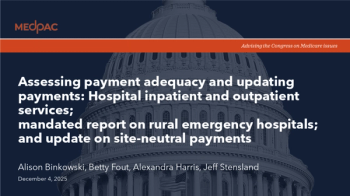
2026 Medicare Physician Fee Schedule has some good, some room to improve, doctor groups say
Key Takeaways
- The 2026 MPFS aims to enhance primary care by modernizing service valuation and supporting behavioral health and at-home care.
- Despite positive changes, the lack of an annual inflationary adjustment for physician reimbursement may lead to financial challenges post-2026.
AAFP, ACP respond with optimism and some critiques in the 2026 Medicare Physician Fee Schedule.
The
The U.S. Centers for Medicare & Medicaid Services (CMS) published the draft MPFS on July 14. This week the
Continuous primary care
The 2026 rule has provisions that will strengthen and sustain comprehensive, continuous primary care within the health care system, according to AAFP. Positive steps include:
- Modernizing how medical services are valued, with changes aimed at better reflecting the real costs of providing care.
- Recognizing that out-of-pocket costs can be a barrier to patient-centered care models.
- Expanding support for behavioral health integration and at-home care by broadening the use of the G2211 and other add-on codes.
“These actions will move us closer to a health care system that prioritizes patients and the preventive care that primary care physicians provide every day to keep the country healthy,” the AAFP statement said.
Physician reimbursement
The 2026 MPFS stops short of creating an annual inflationary adjustment for physician reimbursement. That would be “a necessary step toward ensuring practices can keep up with rising costs and meet patient needs,” the AAFP statement said.
“We are also encouraged that CMS proposed to increase the conversion factor for 2026 by 3.8% for qualifying alternative payment models and 3.6% for all other physicians,” AAFP’s statement said.
However, the majority of increases for 2026 are temporary adjustments included in the One Big Beautiful Bill Act, the national spending plan approved by Congress and President Donald J. Trump. Those will expire at the end of 2026 and for 2027, practices could struggle with a pay cut and inflation, according to AAFP.
Improving payment
ACP President Jason M. Goldman, MD, MACP, published a statement that the 2026 MPFS could strengthen primary care and drive equity and innovation. But the college also called for additional congressional action to protect Medicare beneficiaries’ access to their physicians by strengthening payment for primary care services and preserving access to telehealth.
“On a positive note, ACP is encouraged by CMS’ proposals to improve the valuation process for physician services via a new efficiency adjustment,” Goldman said. “We support CMS' acknowledgement that the time and intensity assumptions built into valuation are often inaccurate. As physicians become more efficient and technology is adopted to free them from nonclinical duties, we urge CMS to acknowledge these improvements through incentives and value-based monetary adjustments. This proposal aligns well with ACP’s recommendations to adopt a more comprehensive valuation approach that combines empirical data with physician input. We will additionally be monitoring CMS’ next steps to enhance the accuracy of the valuation of the global surgical packages.”
SDOH screening
Goldman noted the 2026 rule would remove coverage of screening for social drivers of health, also known as social determinants of health. ACP strongly opposes that measure.
“These screenings are crucial for ensuring that a patient’s overall health is accurately represented in their care,” Goldman said. “CMS should incentivize care arrangements and services that fully capture all aspects of a patient’s health and enhance the coordination of social services by improving data interoperability and reducing the burden of data collection.”
Newsletter
Stay informed and empowered with Medical Economics enewsletter, delivering expert insights, financial strategies, practice management tips and technology trends — tailored for today’s physicians.















